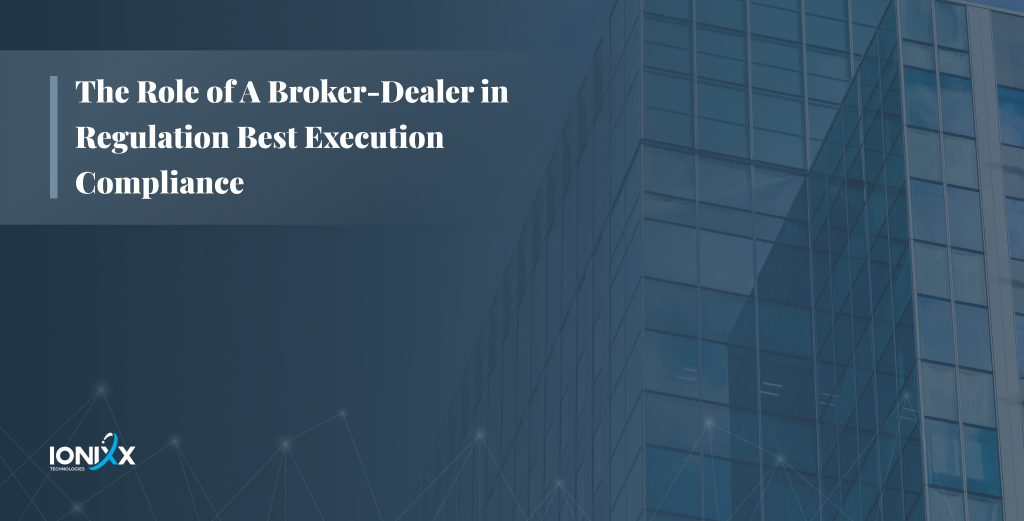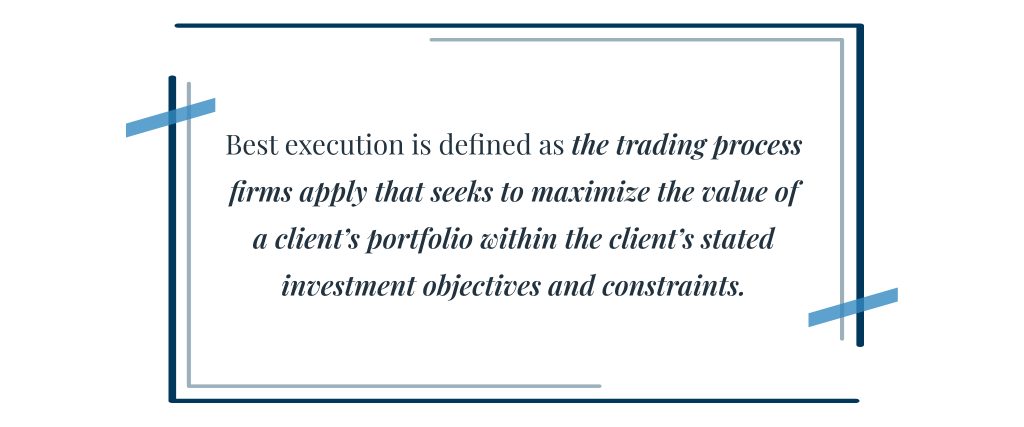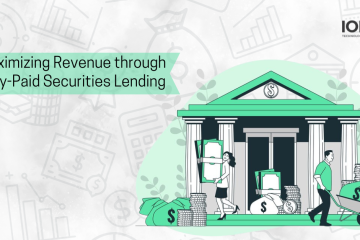
In a bid to ensure that broker-dealers follow through a good-faith effort to seek out and offer the best available market for their customers’ orders, the U.S. Securities and Exchange Commission (SEC) proposed Regulation Best Execution on December 14, 2022.

The SEC Regulation, comprising new Rules 1100, 1101 and 1102 under the Exchange Act, is in part modeled after FINRA’s Rule 5310.
It stipulates that broker-dealers address the following primary and secondary requirements:
Primary
- Set written policies and procedures that describe how they comply with the best interest standard.
- Specifically address “conflicted transactions” for or with a retail customer.
- Review their best execution procedures at least annually.
- Revisit the execution quality of their customer orders at least quarterly.
Secondary
- Comply with the proposed standard of best execution by identifying material potential liquidity sources, incorporating material potential liquidity sources into its order handling practices, and ensuring that they can efficiently access each source.
- Determine the best market for customer orders received by assessing reasonably accessible and timely pricing information and opportunities for price improvement.
At its core, the principle of Best Execution is to promote investor protection and safeguard market integrity.
Differences between FINRA’s Rule And SEC’s Best Execution
Although both FINRA and the Municipal Securities Rulemaking Board (MSRB) have best execution rules, the SEC’s proposal aims to codify the Best Execution obligation at the Commission level for the first time. Here are the nuances.
- The SEC proposal explicitly requires procedures to address specific conflicts.
- However, unlike the FINRA rule; the SEC proposal does not specifically address instances of limited quotations, or pricing information, or foreign securities.
- While the FINRA rule requires firms to maintain adequate staffing to comply with best execution requirements, the proposed SEC regulation does not contain specific requirements to address the prohibition of interjecting a third party between the broker-dealer and the best market.
Key Factors for Best Execution
Several factors govern how broker-dealers evaluate order execution quality. They include:
- Instructions from the client, mandates, and restrictions
- Price offered by the market, costs associated with the transaction, and brokerage fees
- Execution speed
- Marketplace type and location
- Market situation and liquidity
- Order size
- Likelihood of settlement
The Role of Price Improvement As A Key Factor for Best Execution
The SEC has highlighted the role of price improvement opportunities in the context of listed and over-the-counter (“OTC”) equities. Simply routing customer order flow for automated executions or internalizing customer orders on an automated basis at the best bid or offer would not necessarily satisfy a broker-dealer’s duty of Best Execution for small orders in listed and OTC equities.
Typically, Best Execution is used when there is a good-sized bid-ask spread between the times of order placement and the actual order execution. Considering that trades can happen within split seconds, the volatility of price is a key factor while adhering to Best Execution. Since stocks can be highly volatile, Best Execution can be the best-used practice to provide the investor with best price improvement.
Broker-dealers handling small orders in listed and OTC equities should look for price improvement opportunities when executing these orders. The expectation of price improvement for customer orders is particularly important when broker-dealers receive payments in return for routing their customer orders.
The Role of Transaction Cost Analysis (TCA) in Best Execution
With the market becoming more complex than ever, along with the constant need to adhere to the never-ending regulatory requirements pertaining to electronic trading, TCA has made its way in providing both buy-side and sell-side firms with advanced analytics on how their order routing and flow into market has an impact on the quality of their execution.
A well-built TCA has the capability to provide analyses from multiple perspectives within a trade lifecycle. Some of the commonly used analytical tools in the marketplace are:
- Sensitivity Analysis in Trading Costs
- Pre-Trade TCA
- Post-Trade TCA
- Broker Performance
Sensitivity Analysis in Trading Costs
This tool helps in evaluating the changes in the trading costs due to variables such as Average Daily Volume, Volatility, Stock price, Volume, etc.
Performing a sensitivity analysis with these variables helps in estimating the trending trading costs for different market conditions. to help investors understand the trading costs related to the order flow in the market, determining the buy-sell imbalance, portfolio liquidation costs, and other relevant analytics can also be generated.
Pre-trade TCA
In an era of low-touch trading and almost zero-touch trading, pre-trade analysis is the cherry on the cake for most broker-dealer systems.
Pre-trade TCA is useful in understanding the costs of a transaction that is to happen and the risks involved if executed with the market.
According to a 2020 Greenwich Associates report, TCA is now used by 19 out of 20 firms in Europe and nearly 9 out of 10 in the United States.
What does this indicate?
With the rapid growth of novice traders opening accounts with broker-dealers since the COVID-19 pandemic, beginners or first-time traders are quickly adapting to new-age, advanced technological and analytical tools in understanding the market.
Especially when they are not conversant with complex analytical tools, pre-trade TCAs prove a useful tool considering their user-friendly and easy-to-read language.
Post-trade TCA
Post-trade TCA is one of the key tools in most of the standard TCAs that are being used and gives investors a post-trade view of the portfolio returns and profits.
Post the execution of a transaction, this tool provides several metrics for analyzing the results of a carried-out transaction.
Metrics include realized profit and potential profit that fetches the differences between the close price and arrival price with the average execution price.
Broker Performance
Measuring the broker value will help investors understand the true performance of the broker and alter their investment decisions based on it. The broker value is determined by analyzing the arrival costs and estimating trading costs against the actual incurred costs of trading.
A positive value will infer that the broker performance has exceeded the expectations with given market conditions.
Dealing with Fractional/Principal Capacity Trades
In the case of fractional trading which is executed on a principal capacity trading basis, trades are often referred to as conflicted transactions, given their complexity.
An order quantity greater than one can be split into a whole share part and a fractional share part. The whole share part is generally filled at an agent capacity while the fractional share part is filled at principal capacity, i.e.,the broker-dealer usually purchases one-share from the market from its own proprietary account. Meanwhile, the whole share part is purchased from the market under the investor’s brokerage account.
For fractional trading, broker-dealer firms can also ensure that they practice the Best Execution policy for all their trades. Adopting a meticulous approach with checks and control to ensure that the orders are executed at the best price and remain in compliance during two main scenarios.
One, when trying to buy the 1 whole shares directly from the market to satisfy the client fractional order.
Two, when satisfying the client order with an already existing share stocks in the proprietary account (Broker-Dealer’s Inventory); during which there could be day-old stocks sitting with an older price, that was previously bought into the inventory, for fractional trading functions.
Creating a Conflict of Interest: How Payments for Order Flow (PFOFs) Could Affect Investors
Retail broker-dealers receiving cash payments from wholesale market makers in return for routing their customers’ orders to the market maker is a common example of payment for order flow (PFOF).
Typically, PFOFs create a conflict of interest because they provide an incentive to broker-dealers to send customer orders to a market, such as a wholesaler or an exchange, which then agrees to pay the broker-dealer for sending its customer orders.
- PFOFs tend to cause more harm than good to retail customers given how broker-dealers could make order-handling decisions to benefit themselves at the expense of their customers.
- PFOFs are a form of economic inducement that have the potential to influence the way a broker-dealer handles customer orders.
As a result of PFOF’s scope for introducing a conflict of interest, the SEC has stipulated PFOFs be brought under more scrutiny and under a routine assessment check while assessing a broker-dealer’s Best execution compliance.
Example of PFOF practice by Robinhood
An interesting case in point to illustrate the concept of PFOF is Robinhood’s making most of its money of profitability through this method.
Marketed largely as a commission-free trading app, Robinhood had been operating on a business model helping investors with commission-free trading, that solely on a controversial practice called PFOF for more than three-quarters of its revenue in the first quarter.
Sample this: In the first quarter of 2020, 70% of Robinhood’s $130 million in revenue was derived from PFOFs. In the second quarter, Robinhood’s PFOF doubled to $180 million.
Instead of taking fees on the front end in the form of commissions, Robinhood was found to make money behind the scenes, selling their trades to so-called market makers—large, sophisticated quantitative-trading firms(wholesalers) like Citadel Securities and Susquehanna International Group. The big firms would feed Robinhood customer orders into their algorithms and seek to profit from executing the trades by shaving small fractions off bids and offer prices.
Robinhood didn’t invent this selling of orders—E-Trade, for example, earned about $200 million in 2019 through the practice. Unlike most of its competitors, though, Robinhood charges the quants(quantitative-trading firms) a percentage of the spread on each trade it sells, versus a fixed amount. So when there is a large gap between the bid and asked price, everyone wins—except the customer.
Moreover, since Robinhood’s customers tend to trade small quantities of stocks, they are less likely to move markets and are thus at lower risk for the big quants running their models.
The SEC has been actively scrutinizing PFOF over conflicts of interest it says are inherent in the practice.
Broker-dealers that Accept PFOF Versus Those That Don’t
The orders of broker-dealers that receive more PFOF from wholesalers are internalized by wholesalers by three key factors:
(1) higher effective spreads,
(2) higher execution quality ratios, and
(3) slightly smaller price improvement when compared with the orders of broker-dealers that do not receive payment for order flow and that are internalized by wholesalers.
The Effect of PFOF on Broker-dealers
For retail customer transactions that present conflicts of interest, PFOFs could create incentives for a broker-dealer to be less diligent in its search for better executions and potentially result in broker-dealers not providing the best execution to customer orders.
Robinhood gets its profit from market makers/wholesalers in exchange for routing client transactions their way for execution. These wholesalers benefit from the bid-ask spreads.
SEC’s proposed Regulation Best Execution would be a significant milestone that requires that a broker-dealer’s policies and procedures are in place to address how it will comply with the best execution standard in light of such conflicts, including how it would assess a broader range of markets than it would for non-conflicted transactions.
The Effect of PFOF on Retail Investors
Going back to the Robinhood example, retail investors trading on Robinhood are not exactly trading for free. In the pretext of a zero-commission actively marketed by Robinhood, the firm was making money with wholesalers, who were on the receiving end of every retail transaction. The firm’s profit is a direct function of the spread between the bid price and the ask.
The bigger the spread, the better the profit. So the investors’ fees for each transaction was coming from the price improvement that the investor could have possibly enjoyed.
What Do Regulatory Bodies Think of PFOF?
While the SEC has stated that a broker-dealer’s receipt of a PFOF is not a violation of its duty of best execution as long as it periodically assesses the quality of the markets to which it routes order flow, a broker-dealer must not allow payment for order flow to interfere with its efforts to obtain best execution.
FINRA has also stated that obtaining price improvement is a heightened consideration when a broker-dealer receives PFOF and it is especially important to determine that customers are receiving the best price and execution quality opportunities notwithstanding the PFOF.
How Can A Broker-dealer Prepare to Address and Comply with Best Execution?
By Identifying Potential Liquidity Sources
Under SEC’s Proposed Rule 1101(a)(1)(ii), a broker-dealer’s policies and procedures will need to address how it will identify material potential liquidity sources. However, it does not mandate a broker-dealer to include a stipulated number of markets that it would need to identify as material potential liquidity sources.
Rather, under proposed Rules 1101(a)(1)(i) and (ii), a broker-dealer would be required to follow its policies and procedures in assessing reasonably accessible information and determining material potential liquidity sources.
The Role of Broker-dealer’s Business Size in Assessing Liquidity Sources
The SEC believes a broker-dealer’s identification of material potential liquidity sources could be influenced by the nature of the broker-dealer’s business operation and customer order flow. For example, some broker-dealers focus on the handling and execution of institutional orders or large-size orders, while some broker-dealers handle and execute retail orders or small-size orders. These considerations may be relevant to the types of markets or market information that the broker-dealer assesses for purposes of identifying material potential liquidity sources.
The SEC further believes a broker-dealer’s assessment of market information and identification of material potential liquidity sources could vary depending on:
- The trading characteristics of the relevant security
- The level of transparency in the applicable market
- Accessibility of a market, including the cost of maintaining connectivity
- Market data and transactions on the market
For example, if a market charges unreasonably high fees for connectivity, market data, or transactions, a broker-dealer could consider whether such market’s information is reasonably accessible and whether such market should be identified as a material potential liquidity source.
How Ionixx’s OMS Solutions Can Help
Complying with an ever-expanding set of regulatory requirements is imperative for broker firms. Of late, several order management systems (OMS) are designed very specifically with in-built provisions to precisely capture and allocate clients’ orders. They come with extensive execution details captured in an internal database, to help investment firms and broker-dealers better comply with Best Execution.
At Ionixx, we help build dynamic OMS frameworks that help traders better serve the needs of their clients while also ensuring compliance with emerging regulatory requirements. Get in touch.
Further Reading
Ionixx Thought Leadership Series on SEC Rules & Regulations
Regulation Best Interest and its Role in Protecting Market Integrity
Market Access Rule or SEC Regulation 15c3-5 and How Broker-dealers Can Ensure Compliance


